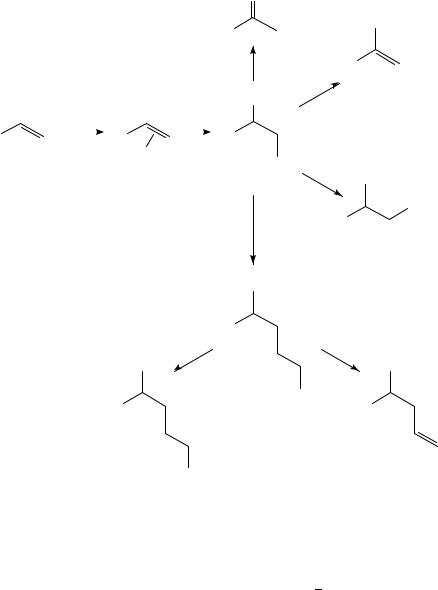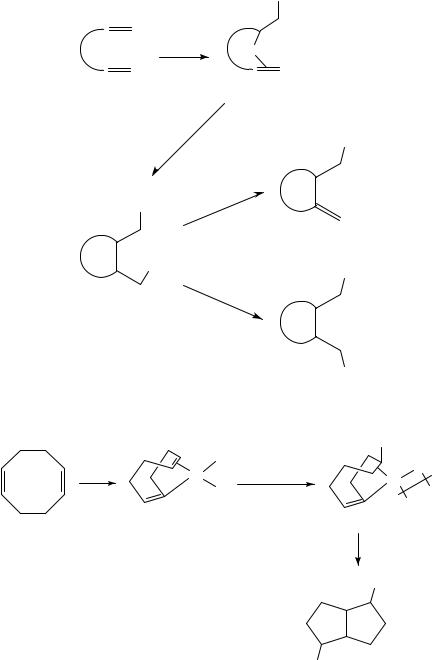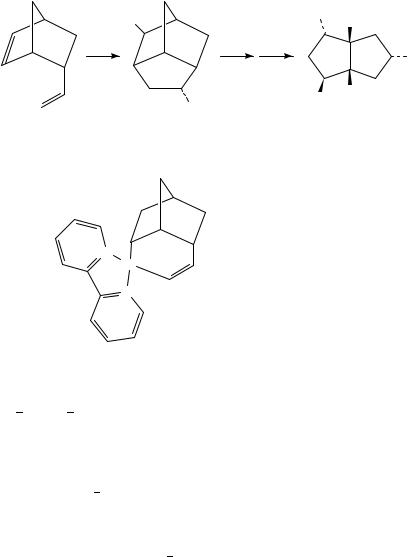

The Chemistry of Dienes and Polyenes. Volume 1
Edited by Zvi Rappoport
Copyright ∂ 1997 John Wiley & Sons, Ltd.
ISBN: 0-471-96512-X
CHAPTER 14
Palladium-catalyzed oxidation of dienes
¨
JAN-E. BACKVALL
Department of Organic Chemistry, University of Uppsala, Box 531, S-751 21 Uppsala, Sweden
I. INTRODUCTION . . . . . . . . . . . . . . . . . . . . . . . . . . . . . . . . . . . . . . |
653 |
A. Principle for the Oxidation of Unsaturated Hydrocarbons . . . . . . . . . . |
654 |
II. NONCONJUGATED DIENES . . . . . . . . . . . . . . . . . . . . . . . . . . . . . . |
655 |
III. CONJUGATED DIENES . . . . . . . . . . . . . . . . . . . . . . . . . . . . . . . . . |
661 |
A. Intermolecular Reactions . . . . . . . . . . . . . . . . . . . . . . . . . . . . . . . |
661 |
B. Intramolecular Reactions . . . . . . . . . . . . . . . . . . . . . . . . . . . . . . . |
668 |
IV. ALLENES . . . . . . . . . . . . . . . . . . . . . . . . . . . . . . . . . . . . . . . . . . . |
677 |
V. REFERENCES . . . . . . . . . . . . . . . . . . . . . . . . . . . . . . . . . . . . . . . . |
679 |
I. INTRODUCTION
Palladium-catalyzed oxidation of hydrocarbons has been a matter of intense research for about four decades. The field was initiated by the development of the aerobic oxidation of ethylene to acetaldehyde catalyzed by palladium chloride and co-catalyzed by cupric chloride (the Wacker process, equation 1)1.
PdCl2 |
|
CuCl2 |
|
CH2DCH2 C 1/2 O2 ! CH3CHO |
1 |
A number of reviews dealing with the palladium-catalyzed oxidation of unsaturated hydrocarbons have been written2 8. The present review will focus on the palladiumcatalyzed oxidation of dienes including both conjugated and nonconjugated dienes. Since this topic has been thoroughly reviewed up to ca 1979 in the book by Henry2 the present review will mainly cover the time period 1979 95. During this time several reviews3 7 have been written which partly cover the present topic.
653

654 |
Jan-E. Backvall¨ |
A. Principle for the Oxidation of Unsaturated Hydrocarbons
In most palladium-catalyzed oxidations of unsaturated hydrocarbons the reaction begins with a coordination of the double bond to palladium(II). In such palladium(II) olefin complexes (1), which are square planar d8 complexes, the double bond is activated towards further reactions, in particular towards nucleophilic attack. A fairly strong interaction between a vacant orbital on palladium and the filled -orbital on the alkene, together with only a weak interaction between a filled metal d-orbital and the olefin Ł -orbital (back donation), leads to an electrophilic activation of the alkene9.
PdII
(1)
If the unsaturated hydrocarbon is a diene, both double bonds may coordinate to palladium(II). (Diene)palladium(II) complexes have been isolated and characterized. For example, 2 and 3 are stable complexes in which both double bonds are coordinated to the metal10. Conjugated dienes constitute a special case and although 4-diene complexes, e.g. 4, are postulated as intermediates, they have not yet been isolated. The butadiene complex 4 is in equilibrium with the -allyl complex 5 in solution, and attempts to isolate the diene complex from this mixture lead to formation of a yellow crystalline complex 511.
Cl |
|
|
Pd |
Cl |
Pd |
|
|
||
|
Pd |
PdCl/2 |
||
|
|
|
||
|
|
|
|
|
Cl |
Cl |
|
Cl |
Cl |
|
|
Cl |
|
|
(2) |
|
(3) |
(4) |
(5) |
A common pathway in palladium-catalyzed oxidation reactions is that the -olefin complex formed reacts with a nucleophile, either external or coordinated, and the new organometallic intermediate may then undergo a number of different reactions (Scheme 1):
(i) an intramolecular hydride shift leads to ketone formation; (ii) a ˇ-elimination results in the formation of a vinyl functionalized olefin; (iii) an oxidative cleavage of the palladium carbon bond produces a 1,2-functionalized olefin7; and (iv) an insertion reaction, exemplified by insertion of an olefin, leads to formation of a new palladium carbon bond, which may be cleaved according to one of the previous processes (ˇ-elimination or oxidative cleavage). In all cases palladium has removed 2 electrons from the organic molecule, which becomes oxidized. These electrons, which end up on Pd(0), are in turn transferred to the oxidant and Pd(II) is regenerated. In this way a palladium(II)-catalyzed oxidation is realized.

14. Palladium-catalyzed oxidation of dienes |
655 |
O
R
Nu = OH (i)
Nu |
β-elim. |
|
(ii) |
||
|
|
Pd(II) |
|
Nu |
|
R |
|
R |
|
R |
|
|
|||
PdII
PdII
Nu′
ox.
(iii)
(iv) CH2  CH2
CH2
Nu
R
Nu
R
Nu
Nu′
R
β-elim.
Nu |
Nu′ |
Nu |
|
ox. |
|
|
|
PdII |
R |
|
R |
Nu′
SCHEME 1
II. NONCONJUGATED DIENES
As mentioned above nonconjugated dienes give stable complexes where the two double bonds can form a chelate complex. A common pathway in palladium-catalyzed oxidation of nonconjugated dienes is that, after a first nucleophilic addition to one of the double bonds, the second double bond inserts into the palladium carbon bond. The new ( -alkyl)palladium complex produced can then undergo a ˇ-elimination or an oxidative cleavage reaction (Scheme 2). An early example of this type of reaction, although not catalytic, was reported by Tsuji and Takahashi (equation 2)12.

656 |
Jan-E. Backvall¨ |
Nu
Pd(II) |
|
Nu |
Pd |
CuX2 or X2
insertion
β-elimination
Nu
PdX
oxidative cleavage
SCHEME 2
Nu
Nu
X
CH(CO2 Me)2
|
|
Cl |
|
Cl |
PdCl2 |
Pd |
−CH(CO2Me)2 |
|
|
Pd |
|
|||
|
|
Cl |
|
|
|
|
|
|
|
|
|
|
|
2 |
|
|
|
−CH(CO2Me)2 DMSO |
(2) |
|
|
|
|
CH(CO2 Me)2
CH(CO2 Me)2

14. Palladium-catalyzed oxidation of dienes |
657 |
In this reaction the first addition product was isolated. In catalytic reactions this is not the case and in these reactions the first ( -alkyl)palladium complex formed from the nucleophilic addition reacts further. For example, in the palladium-catalyzed oxidation of 1,5-cyclooctadiene with Pb(OAc)4 in acetic acid the corresponding diacetate 6 was obtained in 76% yield together with some chloroacetate (equation 3)13,14. Adduct 7 is the suggested intermediate. An additional number of such palladium-catalyzed cyclizations of nonconjugated dienes have been reported15 21. In this system the two nucleophiles incorporated are either two acetates or one acetate and one chloride. For example, norbornadiene gives a mixture of three products, 8, 9a and 9b, where the chloroacetate 8 is the main product (equation 4)15. Another example is the reaction of vinylnorbornene 10, which gives a substituted brendane system 11 in good selectivity and yield16,20. The latter compound was transformed to the important synthetic intermediate 12 containing 5 stereogenic centers (equation 5). This transformation was done via hydrolysis, oxidation to ketone and subsequent Beyer-Villiger oxidation.
|
H |
OAc |
|
H |
OAc |
|
|
|
|
||
+ |
PdCl2 |
|
+ |
|
|
Pb(OAc)4 |
|
|
|
||
|
HOAc |
|
|
|
|
|
H |
|
Cl |
H |
|
|
AcO |
|
|
|
|
|
(6) 76% |
|
|
trace |
|
(3)
OAc
PdCl
H
(7)
PdCl2 , CuCl2 |
+ |
|
|
|
|
|
|
HOA c |
X |
OAc |
|
|
OAc |
|
|
|
Cl |
|
|
(8) 56% |
(9a) |
X = Cl (13%) |
|
|
|
(9b) |
X = OAc (13%) |
(4)

658 Jan-E. Backvall¨
AcO |
HO |
H |
|
||
|
|
CO2 Me
H
Cl
Cl
(10) |
(11) |
(12) |
Isolated intermediate:
(5)
N |
|
Pd+ |
− |
BF4 |
|
N |
|
(13)
The palladium-catalyzed oxidations of the nonconjugated dienes to give products such as 6, 8, 9 and 11 involve three fundamental organometallic reactions: nucleophilic addition insertion oxidative cleavage of the Pd C bond. It is interesting to note that in the formation of 6 and 11 all three reactions are highly stereoselective. It is generally assumed that the first two reactions are always stereospecific, while the oxidative cleavage may occur with either retention or inversion. The organopalladium intermediate was trapped by the addition of AgBF4 and bipyridyl and in this way the cationic complex 13 was isolated.
When the PdCl2 CuCl2 system was applied to 1,2-divinylcyclohexane 14, only one nucleophile is added to the diene system (equation 6)16. After nucleophilic addition and insertion the -palladium complex 15 formed undergoes a ˇ-elimination. The primary product 16 generated undergoes a double bond isomerization to give 17, which is the product observed. The latter reaction has been improved and developed into a synthetically useful reaction3,4,22 25. By changing the oxidation system to MnO2/p- benzoquinone(BQ)26 in acetic acid with Pd(OAc)2 as catalyst, the product 16 with the exo methylene compound was obtained (equation 7)22. In the copper-catalyzed reaction the latter compound was postulated as the primary product, which under the reaction conditions undergoes an isomerization to the observed product. With MnO2/BQ as the oxidation system, 16 does not isomerize.

|
14. Palladium-catalyzed oxidation of dienes |
659 |
|||
H |
|
|
|
H |
OAc |
|
PdC l2 - CuC l2 |
|
|||
|
|
|
|
||
|
|
nucleophilic |
|
|
|
|
|
addition-insertion |
|
|
|
|
|
HOA c |
|
|
|
H |
|
|
|
H |
PdII |
|
|
|
|
|
|
(14) |
|
|
|
(15) |
|
|
|
β-elimination |
|
(6) |
|
H |
OAc |
|
H |
OAc |
|
|
|
|
|
||
H |
|
|
(16) |
(17) |
|
H |
H |
OAc |
|
||
|
cat. Pd(OAc)2 |
|
|
cat. BQ |
(7) |
|
MnO2 |
|
|
|
|
|
HOA c |
|
H |
H |
|
(14) |
(16) |
|
Acyclic dienes also undergo the palladium-catalyzed cyclization with the MnO2/BQ oxidation system22. Thus, simple 1,5-hexadiene afforded a 72% isolated yield of cyclized products 18, 19 and 20, with an isomer distribution of 65:25:10, respectively (equation 8). In general, the selectivity and/or yield was lower for the acyclic dienes.
|
OAc |
|
OAc |
|
OAc |
cat. Pd(OAc)2 |
|
|
|
|
|
cat. BQ |
+ |
|
+ |
|
|
|
|
|
|
||
MnO2 , HOA c |
|
|
|||
|
|
|
|
||
(72%) |
|
|
|
|
|
(18) |
|
(19) |
|
(20) |
|
65 |
: |
25 |
: |
10 |
|
(8)

660 |
Jan-E. Backvall¨ |
The palladium-catalyzed oxidation of the 1,2-divinylcyclohexane system was applied to diastereoselective reactions with the use of chiral acids as nucleophiles25. With this technique an asymmetric induction of up to 76% was obtained in the formation of 21 from 14 (equation 9). The use of molecular sieves was essential in order to obtain a good asymmetric induction.
H
Me
+ ArO  COOH
COOH
H
H
|
O |
|
|
C |
Me |
H |
O |
H |
|
||
cat. Pd(OAc)2 |
|
OAr |
cat. BQ
(9)
MnO2
H
(14) |
(21) |
Ar = 2,4-Cl2 C6 H3 76% de
The use of 1,6-diene systems usually does not result in cyclization reactions with palladium(II) salts. For example, with 1,6-heptadiene a ˇ-elimination takes place from the, -intermediate to give diene 22 as the major product (equation 10)27. However, more recently Trost and Burgess21 have shown that with a 4,4-bis(phenylsulfonyl) derivative of 1,6-heptadiene (23) an insertion takes place to give a 5-membered ring product (24, equation 11). The final step of the latter reaction is oxidative cleavage of the palladium carbon bond by CuCl2 to produce a carbon chlorine bond.
|
|
|
OAc |
|
OAc |
|
|
|
|
|
|
|
Pd(OAc)2 |
Pd |
OAc |
β-elimination |
(10) |
|
|
|
|||
|
|
|
|
|
(22) |
PhSO2 |
|
cat. Pd(OAc)2 |
PhSO2 |
OAc |
|
|
|
|
|
|
|
PhSO2 |
|
CuCl2 |
PhSO2 |
Cl |
(11) |
|
|
||||
|
HOAc |
|
|||
|
|
|
|
|
|
|
(23) |
|
|
(24) |
|
Palladium-catalyzed oxidation of 1,4-dienes has also been reported. Thus, Brown and Davidson28 obtained the 1,3-diacetate 25 from oxidation of 1,4-cyclohexadiene by benzoquinone in acetic acid with palladium acetate as the catalyst (Scheme 3). Presumably the reaction proceeds via acetoxypalladation isomerization to give a -allyl intermediate, which subsequently undergoes nucleophilic attack by acetate. This principle, i.e. rearrangement of a ( , -allyl)- to a ( -allyl)palladium complex, has been applied in nonoxidative palladium-catalyzed reactions of 1,4-dienes by Larock and coworkers29. Akermark˚ and coworkers have demonstrated the stereochemistry of this process by the transformation of 1,4-cyclohexadiene to the ( -allyl)palladium complex 26 by treatment

14. Palladium-catalyzed oxidation of dienes |
661 |
||
|
|
AcO |
OAc |
|
cat. Pd(OAc)2 |
|
|
|
benzoquinone |
|
|
|
|
|
|
|
HOA c |
|
|
(25) |
|
||
|
AcO |
AcO |
|
AcOPd |
PdII |
OAc |
|
|
AcO |
SCHEME 3
with palladium chloride in methanol (equation 12)30. The ( -allyl)palladium complex, in which the methoxy group is trans to palladium, was isolated and used for further organic reactions.
|
MeO |
|
MeO |
|
|
|
|
MeOH |
|
β-elimination |
|
PdCl2
ClPd
H Pd Cl
re-addition
MeO
PdCl/2
(26)
(12)
III.CONJUGATED DIENES
A.Intermolecular Reactions
As mentioned in the introduction, -complexes of conjugated dienes with palladium(II) are not stable enough to be isolated. However, reaction of a conjugated diene with PdCl2 in alcoholic solvents or acetic acid gives a ( -allyl)palladium complex 27 in which the

662 |
Jan-E. Backvall¨ |
alcohol or acetic acid has attacked the diene in the 4-position (equation 13)31,32. In a non-nucleophilic solvent a 4-chloro- 3-(1,2,3)-alkenylpalladium complex 28 is formed (equation 14)11,31.
+ |
PdCl2 + |
ROH |
−HCl |
|
|
|
|
OR |
||
ROH |
|
|
PdCl/2 |
|||||||
|
|
|
|
|
(13) |
|||||
|
|
|
|
O |
|
|
||||
|
|
|
|
|
||||||
|
|
|
|
|
|
|
||||
|
|
|
|
|
|
|
|
|||
|
|
|
|
|
(27) |
|
||||
|
|
R = OMe, OEt, RC |
|
|
||||||
+ PdCl2 |
|
|
|
|
Cl |
|
benzene |
||||||
|
|
|||||
|
|
|
|
|||
|
|
|
|
PdCl/2 |
(14) |
|
|
|
|
||||
(28) |
|
|||||
In 1971, Brown and Davidson reported that 1,3-cyclohexadiene undergoes a palladiumcatalyzed 1,4-diacetoxylation of unspecified stereochemistry28. The oxidant employed was p-benzoquinone. They were uncertain about the mechanism at the time but later work has shown that the reaction proceeds via a ( -allyl)palladium intermediate and subsequent
nucleophilic attack by acetate6,7. |
|
In 1981, a stereoselective palladium-catalyzed |
1,4-diacetoxylation of 1,3-dienes |
with p-benzoquinone (BQ) as the oxidant was |
reported33. It was found that |
chloride ions can be used as a stereochemical switch. Thus, in the absence of chloride ions trans diacetoxylation takes place, whereas in the presence of a catalytic amount of chloride ion (as added LiCl) a cis diacetoxylation takes place (Scheme 4). In both cases the reaction is highly 1,4-regioselective. The explanation for
BQ = p-benzoquinone
|
cat. Pd(OAc)2 |
( )n |
|
|
LiOA c |
OAc |
1, 4-trans-addition |
|
AcO |
||
( )n |
BQ, HOA c |
|
|
|
cat. Pd(OAc)2 |
( )n |
|
|
LiOA c, cat. LiCl |
OAc |
1, 4-cis-addition |
|
AcO |
||
|
BQ, HOA c |
|
|
without LiCl |
|
with LiCl |
|
( )n |
AcO− |
( )n |
|
|
OAc |
OAc |
|
Pd |
|
Pd |
|
AcO |
Cl |
|
|
|
|
|
SCHEME 4. Ligand control in Pd-catalyzed 1,4-diacetoxylation
